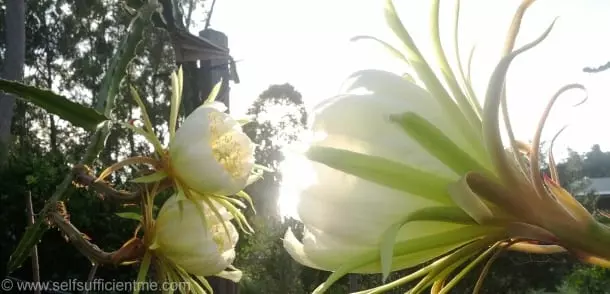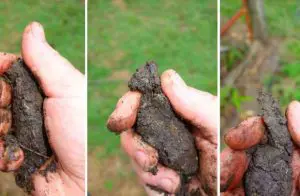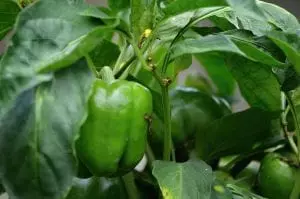Article updated on 13th Jan 2016 Dragon fruit or called by its proper name Pitaya is one of the lessor known fruiting plants in the Western world (perhaps the whole world).
The name “dragon fruit” has its origins in Asia and probably was formed as a way to describe the bright coloured fruit with a chunky scaled skin resembling large…Well, dragon scales, I guess. Whilst this plant is pretty well known in Asia and grown extensively throughout the region, dragon fruit actually originated from Mexico and South America.

Dragon fruit flowers at sunrise (above image)
This medium to large climbing plant is part of the cactus family and like so many other cactus varieties the dragon fruit is an extremely interesting visual spectacle and when grown in the backyard or in a pot on a balcony the plant is always a lure for questions.

The plant grows like a climbing vine but instead of tendrils it shoots from the tip and grows another segment ranging from 1-3 feet long and about 4 inches wide.
In Asia, the fruit is popular and pitaya farms are not an unusual sight. The dragon fruit is growing in popularity throughout the Western world with commercial farms starting to appear among the more traditional fruit crops but generally the fruit isn't well known, yet. I do see the rare case of dragon fruit in my local supermarket and it's promoted as a real exotic treat (with a price tag to match).
Personally, I prefer to grow my own at home.
Varieties of dragon fruit
The most common varieties of this spectacular fruiting cactus are the red and yellow fruiting ones. The re d fruiting variety can be split into two main plants distinguished by the flesh colour (edible part) of the fruit – a white flesh, and the other a dark red flesh with the white fleshed red dragon fruit the most common.
d fruiting variety can be split into two main plants distinguished by the flesh colour (edible part) of the fruit – a white flesh, and the other a dark red flesh with the white fleshed red dragon fruit the most common.
The yellow skinned (with a white flesh) dragon fruit are not as commonly grown as the red variety mainly because of its nasty thorny protection, which needs to be removed before handling (more about that later). Also, the yellow variety is significantly smaller than the red in size. However, out of the two colours the yellow has a better taste (sweeter) than the red variety but that's my personal opinion.
What does the fruit taste like?
With such a glamorous exterior, you would expect the dragon fruit to deliver more than it does – taste wise. Having said that, one shouldn’t try and compare this fruit to other tropical stand-outs just because of how vibrant it looks. The main point is the fruit does not taste bad it just isn't a taste bud celebration with every mouthful, but it does taste good. Let me clarify by saying I really enjoy eating dragon fruit!

Dragon fruit pulp close-up (image above)
Some would say the fruit tastes a little bland but I think the same about some varieties of watermelon and that doesn't stop me from eating them. The taste of the dragon fruit is like a melon with the texture and tiny seeds similar to a kiwi fruit. And just like a kiwi fruit, you hardly notice the seeds when eating the dragon fruit pulp. In fact, crunching a few seeds in a bite releases a slight tang (or acidity) which is quite pleasant.

The fruit is best eaten a little chilled (whole in the fridge), then cut in half and the pulp scooped out with a spoon. Eaten this way, I find the fruit quite refreshing and very enjoyable – I could eat lots of them. Alternatively, dragon fruit are good mashed in cocktails or cut into chunks and added to fruit salads, which by doing so can only enhance the overall fruit salad taste and definitely will not detract from it.
Out of the common red and yellow varieties of dragon fruit, the sweetest tasting is the yellow. However, the drawback for growing the yellow variety (unlike the red) is the fact that the fruit develops spines (thorns) up to and over a centimetre long, which need to be carefully removed before handling (read more about removing the spikes in harvesting below).
Why grow dragon fruit?
I say, “why not” grow dragon fruit? Here are some reasons why more people should grow this weird looking fruit producing cactus:
-
Healthy – Despite some thinking the fruit tastes bland, it is actually very good for us to eat nutritionally. Dragon fruits contain good levels of fibre, minerals, vitamins (vitamin C), and cancer fighting antioxidants.
-
Ornamental value – Many people collect cactus just for fun and for looking at because they are a spectacular plant genus visually. The flower this plant produces is incredible!
-
Different – In contrast to the rest of the garden the dragon fruit plant can be made into a great feature with its eye-catching fleshy stems. On the table, or at a dinner party the fruit do look fabulous and are a real talking point with guests.
-
Easy – The plant itself is very easy to grow and requires little care or water.
-
Taste – I personally do love the taste and think it's a refreshing fruit to eat or drink if you make it into a cocktail.
-
Retail – The large red dragon fruit sell for a ridiculous $5 a pop in the supermarket (in Australia) – enough said…
How to grow dragon fruit?

The massive flower bud of the dragon fruit (image above)
Where can you grow Dragon Fruit
Dragon fruit can be grown almost anywhere in the world. In very cold climates it needs to be protected or it may struggle as it grows best in a warm climate with mild winters. It can be rather drought proof and survive harsh dry conditions; however, the plant does seem to like regular water (in good draining soil) and this helps it produce better fruit in my experience. Yes, pitaya plants can suffer neglect well but will grow much better in fertile, free draining soil with lots of water.
When (planting, fruiting, harvest)
Planting – Time of year for planting isn't really a consideration. The plant is long lived and being a cactus has natural reserves to make it pretty easy as a self-establisher for getting through planting at any time.
Fruiting and flowering – Fruiting can be sporadic throughout the year with the main flowering in summer and then fruit developing into autumn and winter. A dragon fruit plant in flower is an amazing site to behold with petal span often over 8 inches across! Firstly, the shear size of the flower makes it stand out from 50 yards away and the crisp white outer petals with the rich yellow stamens are beautiful. For the best chance to see these flowers in full glory a dawn rising is required as by mid-morning the flowers are usually closed. The flowers are mostly nocturnal (opening at night only) to be pollinated by the creatures of darkness (moths and bats). Nevertheless, I have seen the flowers open through the day and visited by other insects especially ants.

The dragon fruit flower in all its glory (image above)
Plant maturity inducing flowering seems to work off growth rather then age of the plant. I have found that the dragon fruit plant starts to flower and produce fruit best after it has reached a high-point in growth on whatever structure it is climbing. That is, the single stem reaches up and loops down under its own weight triggering small fractures in the stem wall, which in turn stimulates branching.
I have since learnt decapitation once the vine has grown to an acceptable height is another way to stimulate extra branches and fruit development.
Therefore, growing the plant on posts no higher than 2 metres will not only make harvesting easier but it will produce fruit faster also because it won't need to climb as high before toppling over and spreading.
The other extreme, where the plant is left unchecked to grow up a tall structure or even a tree trunk, is worse because the dragon fruit will just keep climbing up and up making fruit harvesting difficult.
It is on the new branches sprawling over the top of the support structure where most of the new flowers are produced, although, flowers can pop-up anywhere on the plant.
Of course, after the flowers come the fruit and it can be tricky to guess exactly how long the fruit will take to reach maturity because it depends mainly on the size. Some fruit keep growing and get very large (bigger than a man’s fist) and others stop growing and start ripening early. So, from flowering to ripe fruit can take from 6 weeks to several months.
Pollination – You can get self-fertile plants and other plants which require cross pollination from other dragon fruit flowers. Unless you are an enthusiast, try to ensure the dragon fruit plant you buy is self-fertile! However, if you are not sure whether your plant is self-fertile or not you can test it when your first flower comes along by hand pollinating; likewise, if your plants are having trouble setting fruit hand pollination will have to be done.
Hand pollination is a pretty simple process but remember the flower only lives for about 12 hours so timing is important! All Pitaya flowers contain male and female parts. The anthers on the tips of the stamen are the male parts (which are typlically the fluffy middle of the flower that contain pollen) and the stigma is the top of the pistil or the female part of the flower (which is usually the long pollen tube poking out from the centre of the flower leading to the ovule). To hand pollinate, use a small paint brush and rub the anthers to collect the pollen then gently dab the top of the stigma to deposit the pollen and thus fertilise the flower!
 Harvesting – Pitaya (dragon fruit) do not ripen off the plant after harvest. Therefore, before picking the fruit ensure it is fully ripe by visually checking the colour has completely changed from green to red or yellow. Also, the skin should be slightly soft (like a silicon filled ball) when lightly squeezed or poked.
Harvesting – Pitaya (dragon fruit) do not ripen off the plant after harvest. Therefore, before picking the fruit ensure it is fully ripe by visually checking the colour has completely changed from green to red or yellow. Also, the skin should be slightly soft (like a silicon filled ball) when lightly squeezed or poked.
To remove the fruit simply rotate it with a light pull and it should come away rather easily – if it doesn't come off easily it probably isn't fully ripe.
Before picking the yellow fruit, its thorns need to be removed and this can be done by using any implement; for example, a pliers, brush, glove. If the fruit is ripe, the thorns should already be showing signs of shedding anyway and hopefully they will easily rub off without too much problem but care still needs to be taken naturally as the thorns are needle sharp. See my video on how to remove thorns from yellow dragon fruit.
After harvest preservation isn't too bad; however, they are best eaten within a few days.
Propagation and positioning of dragon fruit – Because dragon fruit are a climbing plant they are best grown on a structure. Most people grow the plants on a post and secure the stem to the post as it grows with twine or some sort of material.

A dragon fruit farm (image above)
I have seen images of dragon fruit plants on posts no higher than a standard fence (about 1.5m and that might be ok if you plan to have several plants; however, if just one or two plants are required then I'd go a little higher so there is more space for hanging growth (thus more fruit).
Plants can be started readily from seed but most people purchase a potted plant which are usually a foot or two high. Cuttings are also a very successful way to propagate dragon fruit and it's quite common t o find a segment broken from the plant. More often then not, the segment will grow into a new plant if potted up or even re-planted in the soil as is. If you know someone with dragon fruit plants then getting some freebies should be easy enough.
o find a segment broken from the plant. More often then not, the segment will grow into a new plant if potted up or even re-planted in the soil as is. If you know someone with dragon fruit plants then getting some freebies should be easy enough.
To propagate from seed is a slower way to grow a new dragon fruit plant but it's still a good option if you can only get the fruit. Simply, squash some of the pulp and seed onto some damp kitchen paper and keep slightly damp over a few weeks you should see some of the seeds sprouting and when they get about 1/2 inch high carefully transfer them to individual pots in good seed raising mix. Once the plant gets about 6 inches high, it can then be planted out into where you want it to grow (preferribly up a strong single post).
Soil – One thing that will kill a cactus is over watering or wet feet so ensure the soil is free draining. I live in a sub-tropical climate and because of the high rainfall (and my clay soil) I have ensured my plants are growing on a mound or large pot with the bottom cut out. Being a cactus, it can survive some neglect from lack of water and even nutrients but the plant will quickly rot in heavy soil.
Fertiliser – I feed my dragon fruit plants a mix of chicken and quail manure once or twice a year with an occasional dress of compost and a good mulching (keep the much away from the trunk/stem). A complete commercial fertiliser purchased from a garden centre will do also.
Honestly, this plant will grow well under horrid conditions and neglect but for the best fruit possible some care will help.

Pests & Disease on Dragon Fruit plants
Nothing much attacks this plant or the fruit except for when the fruit ripens and then animals or birds may have a go at it bu t this personally hasn't happened to me. I wouldn't imagine climbing or sitting on a cactus to be an easy or pleasant thing for an animal to do, and I'd like to see my pesky possums try to eat a prickly yellow dragon fruit.
t this personally hasn't happened to me. I wouldn't imagine climbing or sitting on a cactus to be an easy or pleasant thing for an animal to do, and I'd like to see my pesky possums try to eat a prickly yellow dragon fruit.
For those of us (like me) who live in an area with fruit fly you needn't be concerned with this awful pest either as it doesn't sting the fruit so no netting is required!
Fungal problems can sometimes arise through summer when the humidity is high with rust spots appearing and then opening up to rot; however, the plants seem to get over it without any intervention. If the plant looks like it is in big trouble from a fungal attack then sparingly using a fungicide (as directed) should solve the issue. Nevertheless, the dragon fruit plant heals itself well after attacks from fungus or injury through wind etc.
Having said that, recently (Feb 2014) I have had my first serious fungal attack on a dragon fruit vine (red variety) which caused severe dieback. The rust spots started random on certain limbs and then rapidly spread. For now, the treatment I've used is a fungal spray and removal of affected branches – hopefully, this will be good enough! This has only happend on the one plant and it happens to be dual planted with a yellow variety which is NOT affected (strange). I've started a thread about this on our fourm SSC here so I can collect more information about the problem and detail progress in solvign or preventing it.
Also, I have read a dose of Epsom salts (as directed on packet manuf instructions) watered into the base of the plant may help it recover from sunburn.
Handy links
You can buy dragon fruit plants online plus many other dragon fruit products to try before you grow on Amazon (USA) or eBay (USA)
In Australia, there are plenty of cuttings and seed etc to buy stright from eBay (Australia).
Want to make a Dragon Fruit Trellis? Check out this article – How to Build a Dragon Fruit Trellis.
Conclusion
If you are already a fan of cactus plants then getting a pitaya/dragon fruit plant is an easy decision; even just for the ornamental value.
If you're interested in food gardening then this easy to care for Mexican born, Asian raised, rebel of a plant will be the heavy metal rocker in your quaint garden especially at flowering time. You need to get a dragon fruit plant just so you can get up at dawn, take a picture of these massive flowers, and brag to your friends.
plant will be the heavy metal rocker in your quaint garden especially at flowering time. You need to get a dragon fruit plant just so you can get up at dawn, take a picture of these massive flowers, and brag to your friends.
And, if you're not really a cactus fan nor an avid food gardener then why not start your new passion with an exotic like the pitaya aka dragon fruit – this plant will not fail you.
Feel free to use the comment section below and have your say (no email is required) but what would really be even better is if you visited our dragon fruit thread on our forum simply join up (free) and chat with us.
Thanks for reading and thanks for your support.
Look, and see the Earth through her eyes
Mark Valencia – Editor SSM
Here's a video showing a dragon fruit flowering at night
Watch more dragon fruit videos












